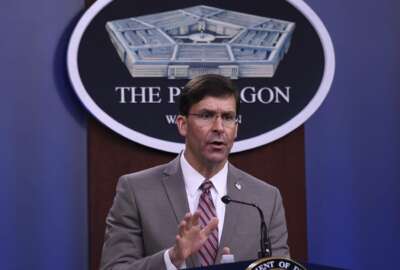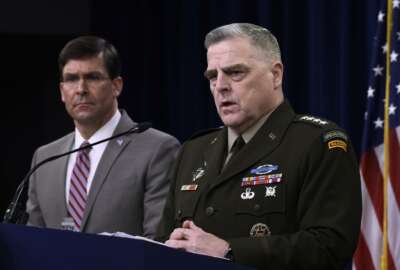
DoD will begin coronavirus testing, quarantining all troops about to deploy
The Pentagon is moving to a screening and diagnostic approach for coronavirus.
The Defense Department is attempting to proactively identify symptomatic and asymptomatic cases of coronavirus in its ranks to an effort to stop the spread of the disease.
DoD says it will be able to test all of its troops working in critical national capabilities by the end of April.
The Pentagon is implementing new policies for individuals who cannot operate with six feet of separation like new recruits and sailors on ships.
“The first step will be to screen with questionnaires and thermometers to identify the at-risk individuals,” Deputy Defense Secretary David Norquist said Wednesday at the Pentagon.
The next step is to start a two-to-three week quarantine for individuals who may be infected, but are not showing symptoms. Norquist said troops will be put into quarantine if they have a possible exposure to the virus that cannot yet show up on a test. The quarantine would allow symptoms to develop or for the test to identify an infection.
“We don’t know that after 14 days when you test positive if you are still contagious,” Norquist said. “These are all the measures we have to do through and our research is trying to understand how long you are contagious, if you’re asymptomatic are you contagious and can you get it a second time?
Before leaving quarantine there will be a swab test and temperature check to identify those infected, but who still do not show symptoms.
“Procedures like face covering, hand washing, maintaining clean work spaces and continuing monitoring will all still apply as the unit moves forward,” Norquist said.
He added that the measures will help DoD continue to operate until therapeutic drugs are developed to combat coronavirus.
“We are moving from a diagnostic focus to a diagnostic plus screening focus,” Vice Chairman of the Joint Chiefs of Staff Gen. John Hyten said. “We are able to expand our testing ability to wider military populations.”
DoD will prioritize the testing by tiers. The first to undergo the testing will be those working on critical national capabilities like nuclear deterrence. Engaged fielded forces around the world comprise tier two. Next come forward deployed and redeploying forces. Finally, everyone else will be screened and test.
“Testing by itself does not enable us to improve our readiness and availability,” Hyten said. “However, it is a powerful tool when complying with quarantine and other public health items that can improve our overall force availability.”
DoD labs only have the capacity to test 9,000 kits a day.
Hyten said he expects tiers two and three to be tested by the end of May, but it will be well into the summer before DoD can test the whole force.
“It is a supply issue really now, which causes us not to be able to go down the full spectrum of forces,” he said. “That’s why we came up with the tiered approach.”
To date, nearly 3,600 troops have been infected with the disease.
More research is coming out that substantial chunks of those infected with the virus show no symptoms, but are still contagious.
One of the most telling anecdotes of that realization comes from the USS Theodore Roosevelt, where COVID-19 spread rapidly.
“Out of the 585 cases on the USS Theodore Roosevelt, only 213 were symptomatic,” Defense Secretary Mark Esper said on April 14. “Think about that. There are people who have tested positive, over 300, who were asymptomatic and just moving around. The same could apply to all of us in this room.”
The number of positive cases from the ship has risen to 678 since that comment.
Copyright © 2024 Federal News Network. All rights reserved. This website is not intended for users located within the European Economic Area.
Scott Maucione is a defense reporter for Federal News Network and reports on human capital, workforce and the Defense Department at-large.
Follow @smaucioneWFED






